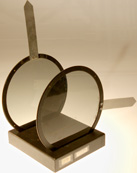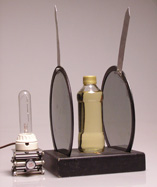We have three linear polarizers with arrows showing the polarization axis. The polarizers can be put on a wood stand with two or three slots, as shown in figure 1.
Demo 1:
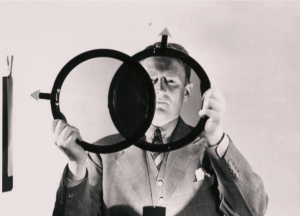
Figure 2: Demonstration of polarizing filters. Image from, Harvard Business School.
Materials:
- Polarizers and wood stand [Cabinet E3]
- (optional) Large flashlight [Cabinet H2]
Setup/Demo:
- Direct a flashlight at the polarizers, or use ambient lighting.
- With polarizers in front of each other, rotate them to shown varying intensities in light.
Demo 2 (Karo Syrup):
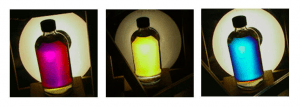
Figure 3: Karo syrup changing color as polarizers are rotated. Image from, labman.
Materials:
- Polarizers and wood stand [Cabinet E3]
- Bottle of Karo syrup [Cabinet E3]
- lightbulb [Cabinet E3]
- Jackstand
Setup/Demo:
- Place both polarizers on the wood stand
- Situate the bottle of Karo syrup between the polarizers
- Place the light bulb on a small jack, and position it behind the polarizer stand
- Rotate one of the polarizers to show spectacular colors
Demo 3 (Polarization by Scattering):
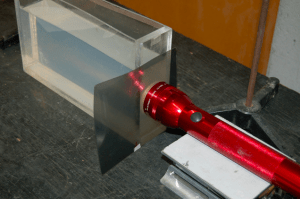
Figure 5: Version of demo from, University of Massachusetts.
Materials:
- Rectangular glass tank filled with water and milk powder [Milk powder in LD labs]
- Large flashlight [Cabinet H2]
- Large polarizer and wood stand [Cabinet E3]
Setup/Demo:
- Place tank of milky water behind a polarizer
- Shine light through the polarizer
Explanation:
What is linearly polarized light?
When light oscillates along a single plane, it is said to be linearly polarized. Most light sources like LEDs, candles, or stars emit light which oscillates along a number of planes. There are many ways to linearly polarize light, and in the case of our polarizers, a unique type of Polaroid filter does so by absorbing light which oscillates along all but one plane. The direction of this plane is shown by the metal arrows on the polarizers.
How do Polaroid filters absorb light oscillating along all but one plane?
They do so by using a sheet of polyvinyl alcohol (PVA), which was heated, stretched, and impregnated with iodine to create an array of conductive polymeric chains. If a plane of light which isn’t perpendicular to these polymeric chains tries to go through, it will induce currents in the chains and have its energy dissipated through heat.
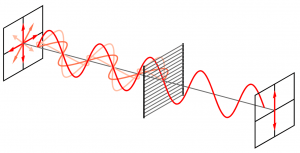
Figure 6: The initial beam of unpolarized light is polarized after loosing waves which weren’t perpendicular to the lines of iodine impregnated PVA. Image from, Wikimedia.
Current can only flow along the chains, and not between them, so waves of light perpendicular to the lines can pass through as they are absorbed much less (figure 6).
Demo 1 and Malus’s Law
When light passes through two polarizers, it is possible to change its intensity when one of the polarizers is rotated.
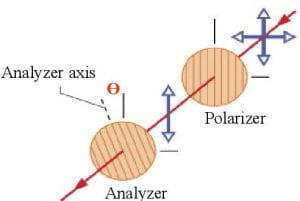
Figure 7: Two polarizers are used to change the intensity of light passing through them, as the second polarizer (AKA the analyzer) has its angle with respect to the first polarizers polarization axis changed. Image from, Semantic Scholar.
In figure 7, polarized light from the first filter passes through a second filter known as an analyzer. When the analyzer is rotated with respect to the first filters polarization axis, it reduces the intensity of the light passing through. The relation between this angle, and the resulting intensity of light is described by Malus’s Law,
where
= resulting intensity of light
= initial intensity of light
= angle with respect to 1st polarizers polarization axis
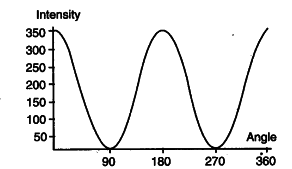
Figure 8: A graph of Malus’s Law shows how the intensity of light is reduced to zero when the axis of the first polarizer is at a right angle with that of the second. Full intensity is achieved when the axes are parallel. Image from, Discourse.
Figure 2 corroborates Malus’s Law, as the overlapping section of the two polarizers is black due to the polarization axes of each being at right angles to one another.
How does Karo syrup between linear polarizers produce vibrant colors?
First, unpolarized light from the lightbulb is linearly polarized by the first filter. Karo syrup is an optically active material, so it rotates the lights plane of oscillation (more on that later). The amount of rotation is dependent on the thickness and concentration of the Karo syrup, and the wavelength (color) of the light passing through. This means that the polarized white light will have its constituent colors rotated different amounts, as different colors are rotated different amounts. When this light exits the Karo syrup, it appears white, as the rotated components cannot be individually discerned by our eyes. The second polarizer is used to filter all but the color of light whose degree of rotation corresponds to the angle of the second polarizers plane of polarization.
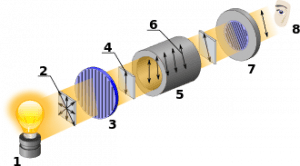
Figure 9: A lightbulb (1) emits unpolarized light (2) which passes through a polarizing filter (3). The now linearly polarized light (4) passes through an optically active material (5), and is rotated. The newly orientated light (6) is allowed to pass though the final polarizing filter (7) which has the same degree of rotation with respect to its polarization axis. Image from Wikimedia.
The polarization rotation in the optically active Karo syrup is a result of circular birefringence. Suspended chiral particles (asymmetric in such a way that the structure and its mirror image are not superimposable) in the Karo syrup can, regardless of their orientation, rotate the plane of polarized light through an effect known as handedness.
Demo 3 and polarization by scattering
Polarization by scattering occurs when light is absorbed, and re-radiated off of molecules. This polarized light is radiated along planes perpendicular to the incident beam of light, with all other angles radiating partially polarized light (figure 10). The polaroid filter is used to show how the polarized light is re-radiated at right angles to the initial beams plane of oscillation. This can be seen when the Polaroid filter has its polarization axis parallel with the table, as the emitted light will only be seen from the top of the milk tank.
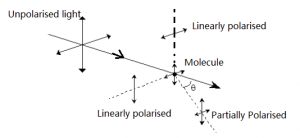
Figure 10: Polarized light is radiated at right angles to the initially unpolarized beam of light. Image from, Harvard University.
If the particles are much smaller than the wavelength (say the proteins in milk powder), the intensity of radiated light is described by Rayleigh scattering,
Written by Aleksander Beck
